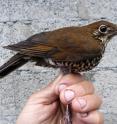New species of bird discovered in India and China by international team of scientists
Related images
(click to enlarge)
A new species of bird has been described in north-eastern India and adjacent parts of China by a team of scientists from Sweden, China, the US, India and Russia, led by Professor Per Alström, Uppsala University and Swedish University of Agricultural Science. The bird has been named the Himalayan Forest Thrush, Zoothera salimalii. The scientific name honours the great Indian ornithologist Dr Sálim Ali (1896-1987), in recognition of his huge contributions to the development of Indian ornithology and nature conservation.
The Himalayan Forest Thrush was first discovered when it was realised that what was considered a single species, the Plain-backed Thrush Zoothera mollissima, was in fact two different species in north-eastern India.
What first caught the attention of the scientists was the fact that the 'Plain-backed Thrushes' in the coniferous and mixed forest had a rather musical song. This was in contrast to individuals found on bare rocky ground above the treeline in the same area, as they had a much harsher, scratchier, more unmusical song.
Studies of museum specimens in several countries revealed consistent differences in plumage and structure between birds that could be assigned to either of these two species. It was confirmed that the species breeding in the forests of the eastern Himalayas had no name.
It was suggested that the high-elevation Plain-backed Thrush be called the 'Alpine Thrush' instead, while retaining the scientific name of the 'original' species, Zoothera mollissima, in accordance with international nomenclatural rules.
Further analyses of plumage, structure, song, DNA and ecology from throughout the range of the 'Plain-backed Thrush' revealed that a third species was present in central China. This was already known, but was treated as a subspecies of 'Plain-backed Thrush'. The scientists called it Sichuan Forest Thrush.
The song of the Sichuan Forest Thrush was found to be even more musical than the song of the Himalayan Forest Thrush.
DNA analyses suggested that these three species have been genetically separated for several million years.
Genetic data from three old museum specimens indicated the presence of yet another unnamed species in China. Future studies are required to confirm this.
The Himalayan Forest Thrush is locally common. It has been overlooked until now because of its close similarity in appearance to the Alpine Thrush.
New bird species are rarely discovered nowadays. In the last 15 years, approximately five new species have been discovered annually on average, mainly in South America. The Himalayan Forest Thrush is only the fourth new bird species described in India since the country achieved its independence (1947).



